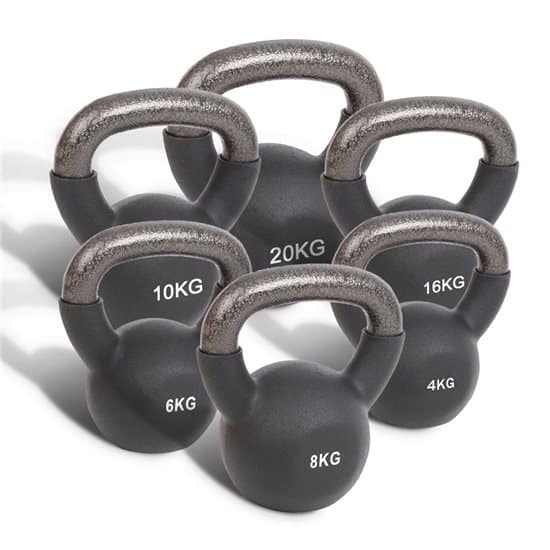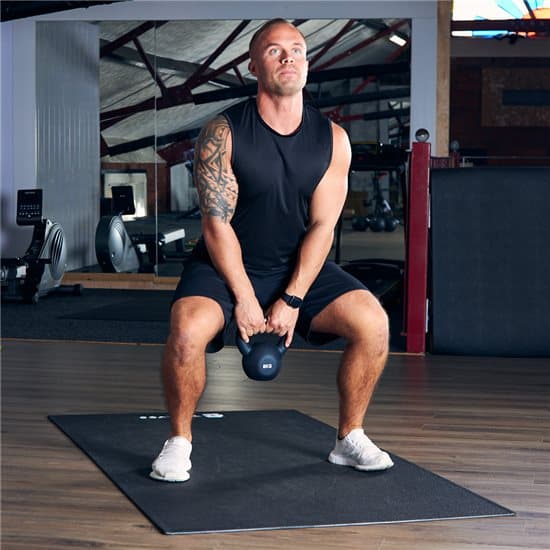Kettlebells are more than just iron balls with handles. If you’ve ever wondered how to use these hand held weights effectively, you’re in the right place.
Join us as we delve into the fundamentals of kettlebell training. Here, we will unravel the techniques and safety precautions. And to help you achieve your fitness goals, we’ll create tailored workout routines. Get ready to transform your body and mind with this powerful training tool!
Getting Started with Kettlebells

Kettlebells are unique and effective fitness tools that resemble cannonballs with handles. Originally used in Russia, these versatile weights have gained global popularity. All thanks to their ability to provide full-body workouts that improve:
- strength
- endurance
- flexibility
Like other weight-focused fitness equipment for gyms, kettlebells are available in various:
- types
- weights
- sizes
The most common types include cast iron, competition, and adjustable kettlebells. Cast iron kettlebells are the traditional and more affordable option. In contrast, competition kettlebells have uniform dimensions for consistent technique training. Adjustable kettlebells allow users to change the weight by adding or removing plates.
Selecting the appropriate kettlebell weight is crucial for a safe and effective workout. Too heavy, you risk injury; too light, and you won’t see significant progress.
When investing in one, look for smooth handles, a flat base, and durable construction. For beginners, starting with a weight that allows for proper form and technique is key. Generally, the ideal weight range is kettlebell 4kg – 20kg.
Remember, mastering kettlebell exercises is a gradual process. Starting with the right weight will set the stage for a successful fitness journey.
Essential Kettlebell Techniques

Mastering these techniques is the key to unlocking the full potential of kettlebells. Here, we’ll guide you through three essential exercises:
1. Kettlebell swing
- Begin with feet shoulder-width apart, hinge at the hips. Hold the kettlebell with both hands between your legs.
- Initiate the swing by driving your hips forward. Use your glutes and core to propel the kettlebell forward and up.
- At the top of the swing, the kettlebell should be at shoulder height. Your body should also form a straight line from head to heels.
- Allow the kettlebell to swing back between your legs. Keep your core engaged and maintain a slight bend in your knees.
- Repeat for the desired number of reps. Make sure to maintain a controlled and fluid motion throughout.
Common mistakes to avoid:
- Rounding the back, which can strain the lower back.
- Using the arms to lift the kettlebell instead of relying on the hip thrust.
- Overarching the lower back at the top of the swing, leading to potential injury.
Top tip: Consider wearing weightlifting gloves for improved grip and hand protection.
2. Goblet squat
- Hold the kettlebell close to your chest with both hands. Stand with feet shoulder-width apart.
- Lower your body into a squat position, keeping your chest up and your back straight.
- Ensure that your knees track over your toes and your thighs are parallel to the ground.
- Push through your heels to return to the starting position.
- Repeat for the desired number of reps, maintaining proper alignment throughout.
Common mistakes to avoid:
- Allowing the knees to collapse inward during the squat.
- Leaning too far forward or rounding the back during the movement.
- Not lowering into a full squat position, limiting the exercise’s effectiveness.
3. Turkish get-up
- Lie on your back, holding the kettlebell in your right hand with your arm extended toward the ceiling.
- Bend your right knee and place your right foot flat on the ground.
- Keep your eyes on the kettlebell, and use your left hand to prop yourself onto your left elbow.
- Push off your left hand to lift your torso off the ground, coming onto your left hand and right knee.
- Stand up by driving through your right foot and fully extending your hips.
- Reverse the movements to return to the starting position.
- Repeat on both sides for the desired number of reps.
Common mistakes to avoid:
- Failing to keep the arm holding the kettlebell straight up toward the ceiling.
- Rushing through the steps, increasing the risk of losing balance and control.
- Neglecting to engage the core, which is crucial for stability during the exercise.
Remember to prioritise proper form and technique over the number of repetitions. Start with a light kettlebell and gradually increase the weight as you gain skill. And when the time comes when you’re going heavy, make sure to wear a training belt for added back support.
By avoiding common mistakes, you can prevent injuries. Most importantly, you can maximise the results of your kettlebell training journey.
Creating a Kettlebell Workout Routine

Below is a sample full-body kettlebell routine that you can add to your 30 minutes HIIT workout:
Beginners
- Goblet squats: 3 sets of 10 reps
- Kettlebell swings: 3 sets of 12 reps
- Kettlebell rows: 3 sets of 8 reps per arm
Intermediate
- Kettlebell lunges: 3 sets of 10 reps per leg
- Turkish get-ups: 3 sets of 5 reps per side
- Kettlebell clean and press: 3 sets of 8 reps per arm
Advanced
- Kettlebell snatches: 4 sets of 6 reps per arm
- Kettlebell windmills: 3 sets of 8 reps per side
- Kettlebell renegade rows: 3 sets of 10 reps per arm
Remember, always warm up before starting the routine and cool down afterwards. Allow enough rest between sessions to aid recovery and prevent overtraining.
Round-up
Kettlebells engage multiple muscle groups, promoting functional strength, core stability, and cardiovascular fitness. They enhance flexibility, coordination, and balance while burning a significant number of calories. Moreover, kettlebell workouts allow for effective full-body training in a short period.
Discover an extensive selection of training weights and home gym supplies at Physioroom. Curious about kettlebells? Explore our beginner’s “What Are Kettlebells” guide for more insights.

